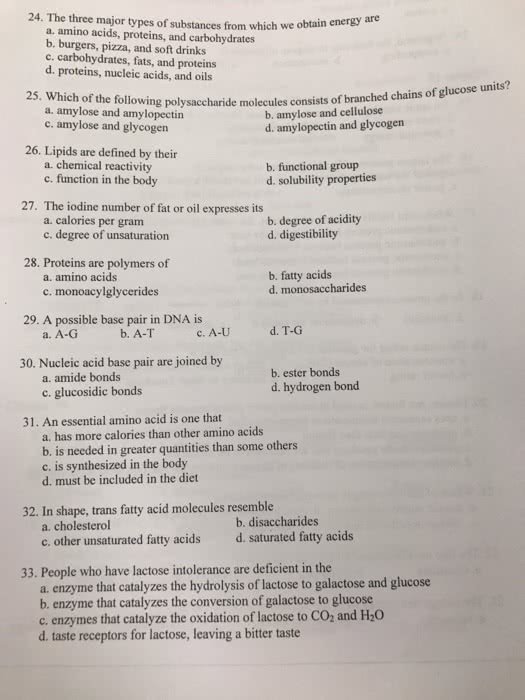NUTR1023 Lecture Notes - Lecture 4: Threonine, Amylose, Low-Density Lipoprotein

NUTR1023 Module Four: Macronutrients
Carbohydrates
• Provide energy particularly during high-intensity exercise
• Regulate fat and protein metabolism
• Exclusive energy source for the nervous system
• Synthesise into muscle and liver glycogen for storage
• Sources include grains, fruit, vegetables, milk and sweet
• Defines chemically as:
-monosaccharides: simple forms of sugar, e.g., glucose, fructose, galactose
-disaccharides: are two monosaccharides joined together, e.g., sucrose, lactose.
Most common pairings are: maltose (two glucose units), sucrose (glucose and
fructose), lactose (galactose and glucose), and they are all linked together
through the process of condensation, and separate through the process of
hydrolysis
-polysaccharides: long chemical chains of individuals sugar molecules e.g.,
starch, glycogen
• Carbohydrates are stored in the body in a polysaccharide called glycogen
• Glycogen molecules contain hundreds of glucose units in highly branched
chains. Each new glycogen molecule needs a special protein from the
attachment of the first glucose
• Starch molecules contains hundreds of glucose molecules in either occasionally
branched chains (amylopectin) or unbranched chains (amylose). Amylopectin
tend to be digested quicker than amylose because there are lots of entry points
for enzymes to get in and attack and break bonds in the molecules
•
• There are numerous types of carbohydrates than cannot be digested or stored in
the body, and they are called fibre
find more resources at oneclass.com
find more resources at oneclass.com

• Although fibre doesn't actually provide the body with any energy, it provides
bulk which helps digestion. Once in the large intestine, it can also bind with
potentially dangerous substances and transport it out of the body in the art of
defecating. A type of fibre is called cellulose, which has a similar chemical bond
to starch, although the bonds itself are different
• Digestion of carbohydrates does numerous processes for the body but it
ultimately results in the appearance of glucose in the blood stream
• Most digestion of carbohydrates takes place in the small intestine
• Monosaccharides enter the capillaries of the small intestines, then travel to the
liver via the portal vein. In the liver, galactose and fructose share metabolic
pathways with glucose. The liver the transmits the glucose to the rest of the cells
of the body. Glucose levels are regulated by two hormones secreted by the
pancreas: insulin (removes glucose from the blood and puts it back into the
cells) and glucagon (stimulated the liver to release glucose and put it back into
the blood stream)
• Low glucose results in not enough energy making it back to the brain, or the
body; too much glucose results in damage to the blood vessels and other tissues
of the body
• The glycaemic index is a way of ranking foods containing carbohydrates
depending on how quickly it is digested, absorbed and seen in the blood stream
• Low GI is <55; moderate 56-69; high >70. Factors influencing GI include
protein, fat, fibre, and other foods consumed. So its not a set rule that low GI
food are good for the body
• Low-carbohydrate diets have positive effects on metabolic risk factors
Protein & Amino Acids
• Makes up all cell structure
• Helps develop, repair and maintain tissues
• Produces haemoglobin, enzymes, and many hormones
• Maintains normal blood osmotic pressure
• Forms antibodies
• Can be an energy source
• Breaks down into amino acids to be used by the body
• Diary, eggs, meat, fish, beans, nuts, seeds, etc.
• 16% of body weight is protein. 43% is in the skeletal muscle; 26% in body
organs; and the rest is in skin and blood
• Protein is chemically different to all the other macronutrients because it contains
nitrogen in addition to carbon, oxygen and hydrogen
• The proteins in the body are made up of 20 different amino acids
Essential amino acids (body cannot produce these acids itself):
-histidine
-isoleucine
-leucine
-lysine
-methionine
-phenylalanine
-threonine
-tryptophan
-valine
Nonessential amino acids (can be made from the essential acids):
find more resources at oneclass.com
find more resources at oneclass.com
Document Summary
Carbohydrates: provide energy particularly during high-intensity exercise, regulate fat and protein metabolism, exclusive energy source for the nervous system, synthesise into muscle and liver glycogen for storage, sources include grains, fruit, vegetables, milk and sweet, defines chemically as: Monosaccharides: simple forms of sugar, e. g. , glucose, fructose, galactose. Disaccharides: are two monosaccharides joined together, e. g. , sucrose, lactose. Most common pairings are: maltose (two glucose units), sucrose (glucose and fructose), lactose (galactose and glucose), and they are all linked together through the process of condensation, and separate through the process of hydrolysis. Polysaccharides: long chemical chains of individuals sugar molecules e. g. , starch, glycogen: carbohydrates are stored in the body in a polysaccharide called glycogen, glycogen molecules contain hundreds of glucose units in highly branched chains. Each new glycogen molecule needs a special protein from the attachment of the first glucose: starch molecules contains hundreds of glucose molecules in either occasionally branched chains (amylopectin) or unbranched chains (amylose).



